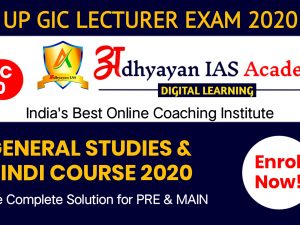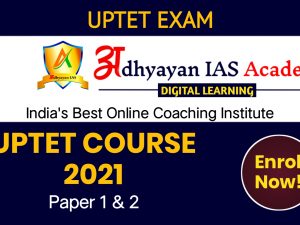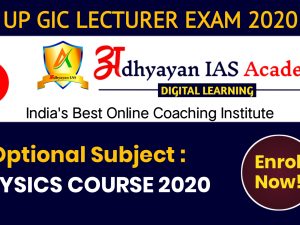
- Description
- Curriculum
- Reviews
उ0प्र0 माध्यमिक शिक्षा सेवा चयन बोर्ड
TGT
विषय–विज्ञान (05)
UP TGT Science(PHYSICS & CHEMISTRY) exam 2025 course is design such the way that it will be helpful to the aspirants in all the sphere of subject. There are the following important feature of this course.
- This course cover all the dimension of subject.
- details and topic wise notes. whole the course contains all the video lecture at all topics.
- The course concept of physics TGT is divided into the three basics parameter of subject of Physics & Chemistry.
- The TGT PHYSICS & Chemistry will covers Numerical section of physics, theoretical section and applied theory concept of Physics .
- The brain storming concept and Brain Map of particular topic of Physics and Chemistry.
- Topic wise test and its valuation by expert subject mentor.
- Low fee and high relevancy of exam questions.
- To register the course follow the link of https://adhyayanias.com/courses/up-tgt-science-adhyayan-ias-academy/
- You can get all the essentials information about the course here and above link.
-
30Structure of Atom
- Discovery of Electron
- measurement of e/m for electrons
- Determination of charge on an electron
- Definition of an Electron
- Positive rays
- proton
- Neutron
- Subatomic particles
- Rutherford's Atomic model
- Mosley's determination of Atomic number
- Mass Number
- Composition of the Nucleous
- Quantum theory and Bohr's Model
-
31Structure of Atom-II ( Wave Mechanical Model )
This lesson covers the following topics:
- Wave mechanical concept of Atom
- De broglie's Equation
- Heisenberg's Uncertainity Principle
- Schrodinger's Wave Equation
- Charge cloud concept and Orbitals
- Quantum Numbers
- Pauli's Exlusion Principle
- Energy distribution and orbitals
- Distribution of Electrons in orbitals
- Representation of Electron configuration
- Ground state Electronic configuration of Elements
- Ionization Energy
- Measurement of Ionization Energies
- Electron affinity
- Electronegativity
-
32Isotopes, Isobars and Isotones
This lesson has the following topics
- Whats are isotopes
- Representation of Isotopes
- Identitification of Isotopes
- Isotopic effects
- What are isobars?
- What are Isotones?
-
33Radioactivity
This lesson has the following topics:
- Radioactivity
- Types of radioactivity
- Properties of Radiation
- Detection and measurement of radioactivity
- Type of radioactive decay
- The group displacement Law
- half life
- Nuclear reaction
- Nuclear fission reaction
- nuclear fussion reaction
- Mass defect
- Nuclear binding energy
- Artificial Radioactivity
-
34Chemical Bonding-I (Lewis Theory)
This lesson has the following topics:
- Electronic Theory of valance
- Ionic bond
- Example of Ionic Compunds
- Characterstics of Ionic Compounds
- Covalent Bond
- Example of covalent Bond
- Characterstics of Covalent compounds
- Co-ordinate covalent compounds
- Example of co-ordinate compound
- polar covalent bonds
- Hydrogen bonding
- metallic bonding
- Geometrics of compounds
- VSPER Theory
-
35Chemical bonding -II ( Orbital theory)
This lesson has the following topics:
- Bond formation
- Valance bond theory
- Nature of covalent bond
- Sigma bond
- pi Bond
- Concept of hybridization
- Type of hybridization
- Hybridization and shape of molecules
- Bond order
- Homonuclear Diatomic molecules
- Heteronuclear Diatomic molecules
-
36Chemical Reaction
This lesson contains the following topics:
- Symbols and Ions formula
- Physical and Chemical Change
- Types of Chemical Reactions
- Chemical Equations
-
37Electro-Chemical cell
Synopsis of Chapter
- Volta cell and its working Process
- Dry cell
- Lead - Acid battery
- Revesible cell
- Electrode Potential
- Nert's law and its application
-
39General Organic Chemistry
This chapter contains the following topics:
-
40Isomerism
Synopsis
- Constitutional Isomerism
- Geometrical Isomerism
- Optical Isomerism and activity
-
41Alkanes
This chapter has the following topics:
- Structure of Alkenes
- Nomenclature of Alkanes
- Preparation of Alkanes
- Physical Properties of Alkanes
- Chemical Properties of Alkanes
- Halogenation of Alkanes
- Electrophilic Mechanism
-
42Alkenes
This chapter has the following topics:
- Orbital Structure of Ethylene
- Nomenclature of Alkenes
- Preparation of Elkenes
- Mechanism of Electrophlic Reactions
-
43Alkynes
Synopsis of chapters
- Orbital Structure of Acetylene
- Nomenclature of Alkynes
- Preparation of Alkynes
- Physical Properties of Alkynes
- Chemical Properties of Alkynes
-
44Alkyl Halides
This chapter has the following topics:
- Orbital Structure of Methyl chloride
- Nomenclature properties of Alkyl Halides
- Physical Properties of alkyl halides
-
45Aldehydes and Ketones
This topic has the following topics:
- Structure of Carbonyl Group
- Nomenclature of Aldehydes
- Nomenclature of ketone
- Physical Properties of Aldehydes and ketones
- Aldol Condesation
-
46Carbohydrates
Topics :
- Classification of Carbohydrates
- Structure of Glocuse , fractose and sucrose
-
47Aromatics Compounds
Synopsis of topics:
- Coal as the source of Aromatics compunds
- Petroleum as the source of Aromatics compunds
- Nomenclature of Aromatics Compounds
-
48Benzene and its Homologues
Synopsis of topics:
- Structure of Benzene
- Resonance Energy of Benzene
- Halogenation of Benzene
- Properties
-
49Aromatic Halogen Compounds
- Nomenclature of Aryl Halides
- Preparation of Aryl Halides
- Physical Properties and chemical Properties of Arly Halides
- Nucleophilic Displacement reactions
- electrophilic Substitution reactions
- DDT and Benzyl Chloride









